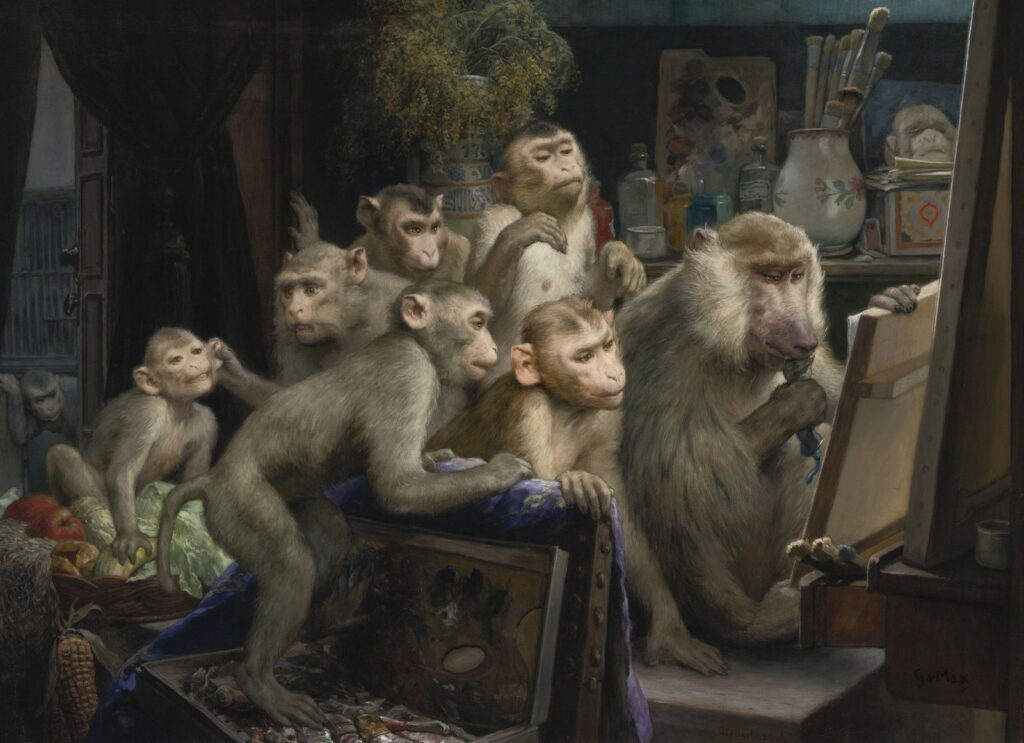Reading visual art: 143 Apes and monkeys, singerie

Not only were monkeys and apes featured in some early European paintings, but in the early 1600s they featured in their own sub-genre of singerie, French for monkeying, as in monkeying about. In these, monkeys dressed up as humans assume the role of humans in an everyday activity. Among the artists who painted singeries were members of the Teniers family.
David Teniers the Younger (1610–1690), A Monkey Encampment (1633), oil on copper, 33 x 41.5 cm, Private collection. Wikimedia Commons.
David Teniers the Younger’s A Monkey Encampment from 1633 shows monkeys in human roles in a camp. They sit talking outside a large tent, staff a stall, and in the background are arriving at a military meeting, presumably involved in the recruitment of the population into its army or militia.
Abraham Teniers (1629–1670), Barbershop with Monkeys and Cats (date not known), oil on copper, 24 x 31 cm, Kunsthistorisches Museum, Vienna, Austria. Wikimedia Commons.
By about 1650, Abraham Teniers developed this into his comic undated Barbershop with Monkeys and Cats. Two cats are sat in the chairs in a barbers, and their attendants are monkeys. The barbershop shown is traditional in that it not only caters for the cutting of hair, but also has facilities and instruments for minor surgery, hence the use of hot coals in cleaning the surgical instruments.
When Holland grew rich in the Golden Age, much of those profits were gambled on tulip flowers, during what became known as Tulipmania or Tulipomania. Bulbs of varieties in demand fetched extremely high prices, which speculation drove into a bubble. When reality returned to the market, prices crashed and fortunes were lost.
Jan Brueghel the Younger (1601–1678), Allegory of Tulipmania (c 1645), oil on panel, 30 × 47.5 cm, Private collection. Wikimedia Commons.
Jan Brueghel the Younger’s Allegory of Tulipmania from about 1645 shows tulip trading during its height, with each figure a monkey dressed in human clothing.
Anthropomorphism of monkeys persisted long after the Golden Age, and elsewhere in Europe.
Antoine Watteau (1684–1721), The Monkey Sculptor (c 1710), oil on canvas tondo, 22 × 21 cm, Musée des Beaux-Arts, Orléans, Loiret, France. Wikimedia Commons.
Antoine Watteau’s tondo of The Monkey Sculptor from about 1710 is another singerie, this time set in the sculptor’s studio.
Zacharie Noterman (1820–1890), Monkey Business (date not known), oil on panel, 31.5 x 26 cm, location not known. Wikimedia Commons.
By the latter half of the nineteenth century, when Darwin was busy unravelling the mysteries of evolution, singerie came back into vogue. One of its exponents was Zacharie Noterman, who painted Monkey Business after about 1850. A monkey dressed as a businessman is plodding through his paperwork, as the bartender stands in front of him, smoking his clay pipe.
Monkeys became popular visual devices for those who wanted to criticise juries and organisers of art exhibitions for excluding their art, and showing members as monkeys is wicked satire.
Hans Canon (1829–1885), African Jury Meeting (1870), oil on canvas, 104 x 143 cm, location not known. Wikimedia Commons.
Hans Canon’s African Jury Meeting from 1870 makes just that comment about a jury which had apparently rejected the artist’s work. In the top right corner is the upper face of the artist himself.
By the end of the eighteenth century, many artists were attempting to portray animals and birds more faithfully to nature, in paintings becoming increasingly objective.
George Garrard (1760-1826), A Marmoset in Three Attitudes (1793), oil on panel, 38.1 x 48.9, Yale Center for British Art, New Haven, CT. Wikimedia Commons.
George Garrard’s A Marmoset in Three Attitudes from 1793 appears to have been intended for a reference description of the species, setting it in its natural habitat and in three postures which the artist took as being characteristic. Unlike later illustrations, though, this painting is painterly in its depiction of vegetation, and is by no means academic or dry.
For one or two artists, singeries were not enough. Gabriel von Max probably painted more works of monkeys or apes than any other artist, from models he kept at his residence by Starnberger Lake, in the Bavarian countryside, where he painted each summer.
Gabriel von Max (1840–1915), Monkeys as Judges of Art (1889), oil on canvas, 85 x 107 cm, Neue Pinakothek, Munich, Germany. Wikimedia Commons.
In von Max’s Monkeys as Judges of Art (1889), a crowd of monkeys are packed together in front of a canvas which already has a gilded frame, and will shortly be announcing their decision on that work. The artist avoids anthropomorphism, and his monkeys look very natural and non-human.
Gabriel von Max (1840–1915), A Visit to the Artist’s Studio (date not known), oil on canvas, 88 х 124 cm, location not known. Wikimedia Commons.
His undated A Visit to the Artist’s Studio shows a similar group of monkeys watching their leader handle von Max’s paint and brushes in his studio. I suspect that the artist may have supplemented his sketches of the group with some photos, as it appears implausible for the monkeys to have remained in much the same positions for long.
Gabriel von Max (1840–1915), Go to Sleep! (1900), oil on canvas, dimensions not known, Private collection. Wikimedia Commons.
Von Max appears to have had tender and personal relationships with his monkeys. In Go to Sleep! from 1900, a young woman, possibly his daughter, is nursing an infant monkey who is staring with tired eyes into the distance. Charles Darwin’s book The Descent of Man had been published in 1871, so by this time von Max would have been well aware of the proposal that monkeys and humans had common ancestors.
Gabriel von Max (1840–1915), Self-Portrait with Monkey (1910), further details not known. Wikimedia Commons.
Von Max’s Self-Portrait with Monkey (1910) shows him at the age of seventy with another young ape.
Serhiy Kolyada (b 1972), The Theory of Origins (2012), ballpoint pen on paper, dimensions and location not known. Courtesy of and © Serhiy Kolyada, via Wikimedia Commons.
Finally, contemporary artist Serhiy Kolyada uses the figure of a painting monkey at the heart of The Theory of Origins (2012). The artist explains:
A painting monkey perhaps a commentary of contemporary art? Protective of its bottle of Teacher’s whisky and looking over its shoulder at a naked Teacher pointing to the supposed “cradle-of-civilization” Africa on a world map; both Teachers providing pupils with an escape? Or knowledge? An Egyptian pyramid, Stonehenge, Mount Kailish, the Temple of Tibet, a UFO and dinosaur, Sator Arepo and yin-&-yang all tease but fail to appease. Puzzles, a Bible, equations and runes add to the confusion, offering no real explanation except to say: Maybe Origin Theories are a mess and human beings have no idea, in fact, of their origins on this planet.



